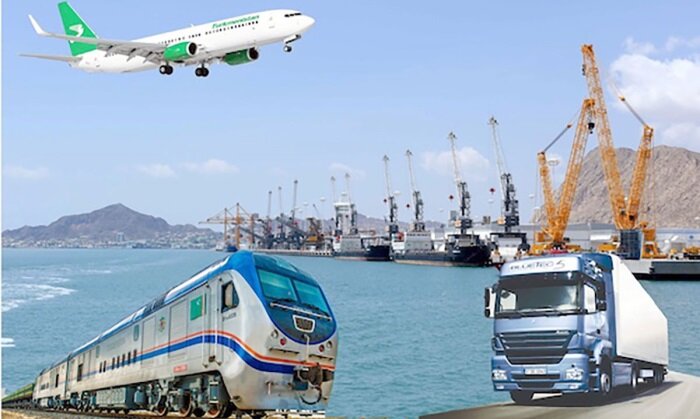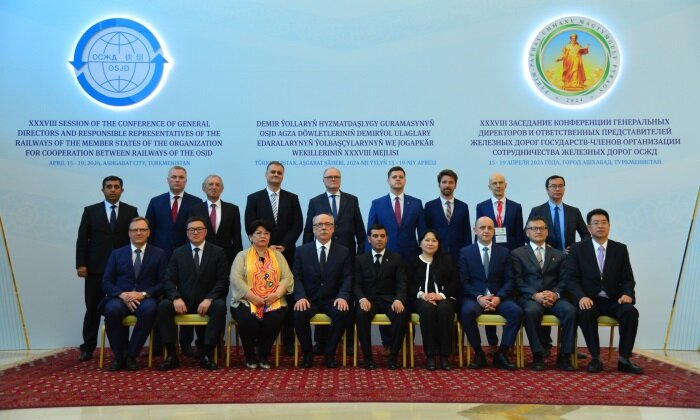 The 21st-century global transport strategy is the concept of an integration breakthrough and the synergy of geographical and infrastructural capacities and technical and technological potential of states and regions. As a consequence, Turkmenistan is resolutely turning into a transcontinental bridge of interaction for the European, Asia-Pacific and South Asian economies. An analyst for Central Asia Vadim Shagiakhmedov comments on it in an interview with CentralAsia.news.
The 21st-century global transport strategy is the concept of an integration breakthrough and the synergy of geographical and infrastructural capacities and technical and technological potential of states and regions. As a consequence, Turkmenistan is resolutely turning into a transcontinental bridge of interaction for the European, Asia-Pacific and South Asian economies. An analyst for Central Asia Vadim Shagiakhmedov comments on it in an interview with CentralAsia.news.
Cooperation concept
The key objectives of Turkmenistan are the expansion of the national transport infrastructure along the main highways, connecting routes and hubs in the East-West and North-South directions. The main goal pursued by Turkmenistan in interaction with the international community in the transport sector is to promote mutually beneficial multilateral partnerships on the world arena. In this vein, ongoing promising measures result in building new bridges, highways, railways, air and sea routes.
Currently, the transport policy of Turkmenistan is characterised by the increased economic competitiveness, expedited freight services and reduced transportation costs. Turkmenistan, as the hub of the grandiose transnational transport corridors on the Eurasian continent, is becoming thus a catalyst for the development of modern multidisciplinary transport infrastructure in the region.
The importance of transport corridors
International freight transport is of huge importance for cooperation of Turkmenistan with other countries, and furthermore, the expansion of the transport sector is an effective factor in addressing socio-economic issues. Due to its geographical location, Turkmenistan is a natural constituent part of transnational transport corridors. Modern highways that meet international requirements and standards and a well-developed infrastructure significantly enhance the transit potential of the country.
The creation of a single integrated transport hub in Central Asia is undoubtedly becoming a key transit link among the states in South Asia, Southeast Asia, Europe, the Near and Middle East. Devising joint actions generates the transit potential of the region, thereby increasing the efficiency of using transnational transport corridors, removing barriers to international transport and improving the regulatory framework and tariff policy.
Development prospects
The prospects of international economic relations and foreign trade of Turkmenistan drive growth in freight transportation, in servicing which the role of all existing and new transport hubs in our state is consistently increasing. The country is accelerating the pace to modernise transport infrastructure through adopting the latest achievements and innovative technologies. Today Turkmenistan, as the hub of the grandiose transnational transport corridors on the continent, is becoming thus a catalyst for the expansion of modern multidisciplinary transport infrastructure of the region.
It is not by chance that the tremendous resource potential and a well-developed logistics infrastructure make Turkmenistan a major participant in global trade. The expansion of transnational transport corridors meets the objectives of Turkmenistan’s transport policy to create effective, safe and reliable international transport channels that ensure sustainable economic growth and meet the needs of society for the transportation of passengers, the movement of goods and services, as well as increase the global competitiveness of Turkmenistan’s transport network.
Environmental issues
Certainly, road, rail, sea, water and air transport operations cause an increased technogenic impact on the environment and poses a serious threat to nature and public health. In this regard, one of the major challenges in the creation and operation of new transnational transport corridors is to ensure their environmental safety, particularly at large transport hubs and in those sections that pass through the border territories of states.
Among the multifaceted tasks of ensuring environmental safety of transport corridors, the crucial one is to set up an effective environmental control system. To achieve this, regulatory documents governing the procedures and implementation of state environmental control of all modes of individual and state transport should work at the regional level. Such documents provide for administrative liability for failure to comply with the requirements and thereby create a mechanism for managing the state environmental control system that ensures compliance with state standards.
Engines of the economy
The progressive dynamics of the development of Turkmenistan’s economy, the constructive initiatives put forward by the country on international platforms to create transport corridors of continental significance, are invariably in focus of the world community. The geo-economic potential of such functions is invaluable; they involve vast spaces, human resources and substantial investments. Therefore, the creation of modern networks of transport corridors has become a vital tool for boosting trade and growth in the age of economic globalization.
All this provides good chances for transforming the transport segment into an engine of global economic development. The ultimate aim of creating transport and transit corridors is to facilitate the unhindered and cost-effective movement of vehicles in various directions. For this our country is successfully addressing mainly transport and technological issues related to the construction and modernisation of routes, terminals, information systems, communication lines, etc.
The effective network
The implementation of ambitious infrastructure projects has a positive impact on the social and economic development of states, provides a multiplier effect and enables them to employ the scientific, financial and human potential of partner countries. However, economic growth of any country in the world will be difficult without the development of a progressive transport network. The existing transit and transport corridors offer great economic preferences to Turkmenistan, increasing the competitiveness of the national transport network.
The existence of a high-tech and multimode transport sector is essential for the implementation of large-scale projects and programmes. And in this is seen the intensification of integration processes, a powerful source that allows using the advantageous geopolitical location of Turkmenistan to boost economic growth, since a well-developed transport infrastructure and a strong network of routes provide the groundwork for successful integration of the Eurasian states into the processes of global economic development. Turkmenistan’s superb transport sector is one of the factors of a fast-growing economy. Certainly, a developed economy, first of all, improves the standard of living of the people and ensures the prosperity of the state.




